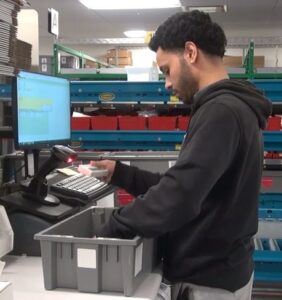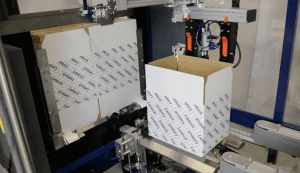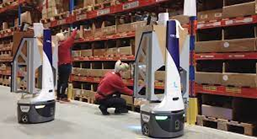One of the most basic operations for any warehouse, distribution center, or customer-serving product supplier is the “Pick and Pack.” As trade blossomed worldwide, it was quickly realized that there IS money (profitability) in ensuring you can bring items into your facility in bulk and then provide end-users with smaller quantities at a marked-up price.
In Other Words, Pick from Large Quantities and Pack Smaller Orders for End-Users = $
Fast-forward from the inception of trade to today, the concept has not changed. This is what gave way to the Walmart’s and Amazon’s of the world.
Today, it is not enough to include a pick-and-pack operation for your warehouse as needed. Because of the post-COVID era, it is with growing difficulty that warehouses find available human operators they can retain to do these functions. When you can find them, you must keep pace with minimum wage laws to ensure you can attempt to retain these employees. As such, more and more businesses are investing in ways to automate these operations.
warehouses find available human operators they can retain to do these functions. When you can find them, you must keep pace with minimum wage laws to ensure you can attempt to retain these employees. As such, more and more businesses are investing in ways to automate these operations.
As an automation specialist, I cannot proceed without the disclaimer:
“AUTOMATING PICK AND PACK OPERATIONS ARE NOT FOR EVERY BUSINESS.”
Well, Irving, which businesses would be prime for automating these processes?
I’m glad you asked – keep reading.
When to Automate Pick and Pack Operations
Assuming you haven’t had a chance to read Warehouse Best Practices Part I & II, the simplest answer is to get with an integrator who can assist in ensuring that your business is ready for automation.
The second-most simple answer… organize and make as efficient as possible your current operations before considering automation. Otherwise, you’ll automate flawed processes and speed up bottlenecks in your operations for which your business may not be prepared.
Automating the Pick
I hope you didn’t just skip to this section… Assuming you didn’t, here are a few key actions/movements to look for to do a quick “eye test” as to whether you should automate (or not).
- Repetitive Movements – if your operator does the same thing repetitively, this is usually a good sign that this specific operation can be automated. It would also be good to ensure this operation is monotonous or has few actions within the repetitive operation.
- Good Repetitive – this is the type of repetitiveness easily mimicable by automation. Think… forming boxes/cartons or closing boxes/cartons that do
 not have weird shapes or require operator dexterity (skill). Also, think about picking solid, similar items; this could be t-shirts or ChapStick, but it adds complexity if you need to do both in the same area. Not impossible to automate, just more costly.
not have weird shapes or require operator dexterity (skill). Also, think about picking solid, similar items; this could be t-shirts or ChapStick, but it adds complexity if you need to do both in the same area. Not impossible to automate, just more costly. - Bad Repetitive – this is the type of repetitiveness that is not easily mimicable by automation. Think… folding one (1) box six or more times to get it fully made/erected. Closing flaps and taping is easy, but if the human operator does more than just close flaps… say, they fold corners twice for customer presentation or marketing/display boxes, then that usually requires much more to automate. However, nothing is out of the question where automation is today – it just takes time and money.
- Good Repetitive – this is the type of repetitiveness easily mimicable by automation. Think… forming boxes/cartons or closing boxes/cartons that do
- Manual Operator Assist – commonly referred to as semi-automated systems. There are several options that allow an operator to focus on the value-added services (VAS), while automation does the repetitive/monotonous, non-VAS.
- Sticking to the carton-erector example, should the box require intricate folds or inserts, a carton erector or other piece of automation can do a portion of the operation while the operator sticks to the VAS operations.
- As for picking, perhaps your operation deters operators from walking to various pick areas. Today, this can be accomplished in various ways, so long
 as the return on investment (ROI) makes sense. It could be a Goods to Picker solution that brings the appropriate product, tote, or shelf that the product is on to the picker, so they don’t have to move. This can be accomplished by Automated Storage and Retrieval Systems (AS/RS solutions) or moving technology like an Autonomous Mobile Robot (AMR) or Automated Guided Vehicle (AGV).
as the return on investment (ROI) makes sense. It could be a Goods to Picker solution that brings the appropriate product, tote, or shelf that the product is on to the picker, so they don’t have to move. This can be accomplished by Automated Storage and Retrieval Systems (AS/RS solutions) or moving technology like an Autonomous Mobile Robot (AMR) or Automated Guided Vehicle (AGV).
Regardless of how the operation is automated, we can alleviate how much work is expected to be performed by workers. This leads to operator satisfaction on the job and helps with operator retention or repurposing to VAS.
Automating the Pack
While pick and pack have almost the exact spelling, these processes could be very different. And at the same time, they can be extremely similar – just in reverse order (taking out vs placing in). It is important to note all that was said about automating the pick when considering automating the pack.
Additionally, keep in mind that picking from large quantities will almost always be more challenging than packing smaller quantities. This fact, added to the rule that you should automate from the shipping areas and go backward to receiving, should almost always be the order to automate.
rule that you should automate from the shipping areas and go backward to receiving, should almost always be the order to automate.
The main reasons you should start from the last operation and go backward are bottlenecks and profits!
Those two reasons usually go hand-in-hand, and that’s because bottlenecks are the opposite of efficient operations. You start from the last operation (shipping or end-of-line operations) because keeping items from being able to ship means your company is unable to realize those profits, which is why businesses exist! The longer orders (products) stay inside your walls, it extends the turnover of those products. This means you can’t bring more products in to keep the business growing and profits coming in!
How to Know Which Solution is Next for Your Company
As mentioned, Warehouse Best Practices Parts I & II are good starting points.
If you’d prefer to stay as hands-off as possible, some companies can help with these initial processes. Abel Womack has a great Lean Management Consulting division specializing in ensuring your company performs as efficiently as possible. You can also contact our Automation team to assist with automation-specific consulting. We’ll uncover the best next step for your operations.
Abel Womack has a history of relationship-building, service, and experience automating facilities new to automation. We also work with companies who are several phases of automation into their long-term plans. Watch us perform these upgrades with a small information-gathering phase to get you to the next steps.





Leave a Reply
You must be logged in to post a comment.